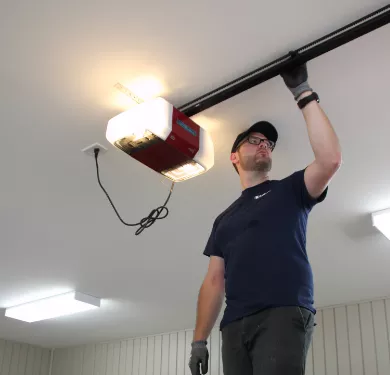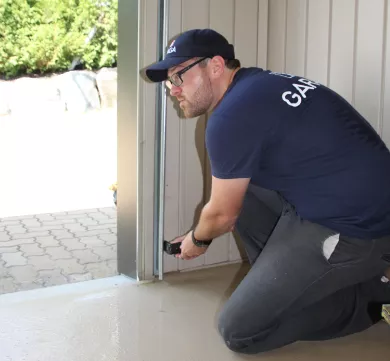You will undoubtedly want to provide your garage door with maintenance each year, or more often, to ensure that it continues to work well. If you don’t, you might find that some problems start to develop, and that is the last thing you need. By detecting and fixing issues as soon as possible, it will help to reduce the cost substantially. It will also reduce the frustration you are sure to feel if something were to go wrong with the door that you could have prevented.

Safety is essential
Keeping your garage door in good working condition is essential not just for your convenience, but also for safety. Many accidents happen each year that can be attributed to garage doors that are malfunctioning for one reason or another. In 2014 in the US alone there were more than 18,000 accidents related to garage doors.
There were three causes for these accidents that showed up time and again. They include component failure, imbalance in the spring system that works as a counterweight for the door, and improper calibration in either the photoelectric or mechanical automatic reversal system. You do not want to take any risks; if there is ever a sign of a problem, it is better to have it checked out by the professionals as soon as possible.
Care for your door
You should scrutinize the garage door about two times per year at least. Typically, you will want to do this in the fall and the springtime. If you use the garage more than a couple of times a day, bump up the inspections to three times per year. Set yourself a reminder if you have to. These inspections tend to be quick, and you should be able to complete them in about half an hour or less. That’s only an hour out of your year to make sure that the garage door is working well. Do a visual inspection of the system, lube the major metal parts of the door, and test the safety features and the balance of the door. Let’s get a closer look at what you need to do.
The inspection
You will want to use both your eyes and your ears when you are inspecting the door. You will want to open and close the door and listen for any sounds that seem out of place, or that could indicate a problem. Grinding and rattling sounds could be problematic, for example.
Look at the lifting cables located near the vertical tracks. Do they look like they are in good condition, or appear frayed? Check out the drum and the cable that is wound around it. Does everything seem to be appropriately aligned?
You will also want to look at the spring system. There are two types of system – extension, and torsion. Extension springs are located over the horizontal tracks, while torsion springs are placed above the door and inserted into a steel tube. Check to see that nothing is broken or about to break.
Check the rollers to see if they are in good condition or are about to break, as well. Are they sliding and rolling properly? Check the hinges to make sure that the bolts have been tightened correctly and that the vibrations have not loosened them. If they have, you can tighten them. Check the bottom brackets to see if they are in good condition, as well.
Does the external frame weatherstripping look worn and frayed, or is it still in good condition? If your door has a photoelectric reversal system, is it clean and clear, or has it become obstructed with grime and dirt? If so, clean it and check it.
Lubricating the system
You will need two different types of lubricants. One is 5W30 car engine oil, which you will be able to use for the metal parts of the door. It includes the spring system, rollers, hinges, and the tracks.
You will also want to have a silicone‑based lubricant that you will use for the weatherstripping at the bottom of the door, between the sections, and on the exterior frame. These specialized lubricants can be bought at Baker Door Company. It is always essential to clean the area before lubricating the important parts. It includes removing any old grease or oil that may previously applied.
Perform safety tests
You will want to make sure that the system is safe and working correctly, so make it a point to check the automatic reverse systems. You should do these tests more often than just once or twice a year to ensure they are working correctly. Some even suggest that you do them about once a month. Fortunately, they are easy.
For testing the mechanical reverse system, you will place a 2x4 flat on the ground where the garage door closes. Close the garage door. When it touches wood, the safety system should ensure that the door reverses direction.

For the photoelectric reversal system test, you will close the garage door with the remote and then pass an object in front of the sensors, which are about 4” to 6” above the ground on both sides of the garage door. When you place an object in this light beam, it breaks the connection and triggers the reversal system.
If you find that either of these is not working correctly, you will want to make sure that you get in touch with Baker Door Company right away.
When you take a little bit of time out of your day to perform these tests a couple of times per year, it will find any problems before they become worse, and it can help to lengthen the life of the garage door system. Also, it can help to reduce the repair costs in some cases, since you can catch the problem nice and early.
Still no time?
Perhaps you do not have the time or the capabilities to handle the garage door maintenance on your own. Maybe you do not feel like you want to do it on your own. That’s not a problem, as well can help. You can contact us at 717-767-1419. We can set up a tune‑up service that is affordable, and that will make sure that your garage door gets the care it needs.
Perhaps you think that you might want to update your entire garage door system. Don’t worry; we can send you a quote by email.








Add new comment